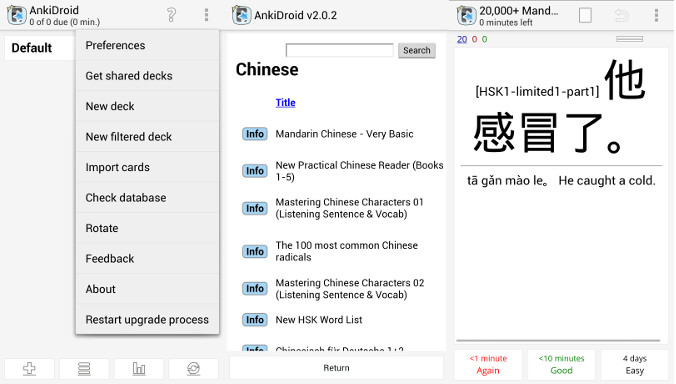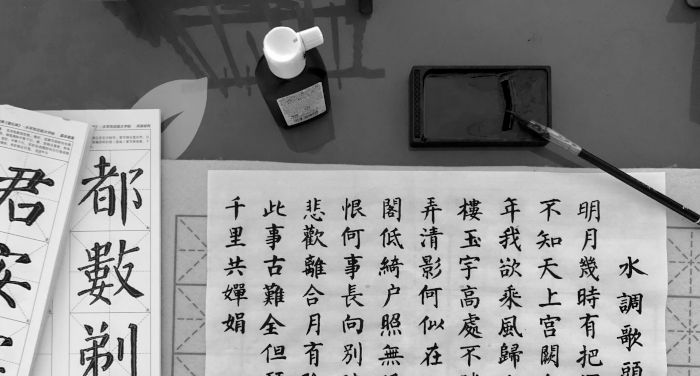A long time ago, Mao Zedong said: “Latinization is an excellent tool for defeating illiteracy“.
Chinese characters
Chinese is a language without an alphabet that uses instead the so-called hanzi (汉字), or “Chinese characters”. To state it briefly – and in a very non-technical way – there are tens of thousands of characters and each corresponds a syllable with a very distinct meaning.
The most complete Chinese dictionaries – such as the Hanyu Dacidian (汉语大词典) “the Great Dictionary of the Chinese Language” edited by the editing house Shanghai Cishu Chuban She (上海辞书出版社) – reports a number of characters ranging from 56,000 to more than 80,000. To be able to read and write fluently in proper Chinese you’ll only need to memorize anywhere between 2,000 and 3,500 characters.
In China this means literacy starts at 2,000 characters and a Chinese person’s culture is measured by how many characters they know.
Memorizing Chinese characters is not always easy. These days there are many techniques and software that help with learning the characters (such as Skritter) but, despite these, you have no choice but to be very patient.
Compared to the “Western” style of writing, it goes without saying the Chinese, with all its characters, is much, much more difficult. So why haven’t Chinese characters been replaced with an alphabetic system of writing?
The reform of writing
Although Chinese characters have a thousand year history, are aesthetically beautiful to look at and help develop an individual’s memory, it was first thought that a reform of writing would be needed to defeat the serious problem of illiteracy.
The reform of writing began after the foundation of the Chinese Popular Republic in 1949, when an official language was adopted, putonghua (普通话) “the common tongue”. On one hand it simplified writing with the adoption of simplified characters; on the other it developed a phonetic system of representation, pinyin (拼音) made up of 26 Latin letters.
Mao Zedong tasked a linguist, the “Father of Pinyin”, Zhou Youguang (周有光) with the development of this phonetic system of transcription to make Chinese more accessible to the masses.
Pinyin literally means “spelled sound”. After its development, pinyin was immediately proposed as an aid for the learning of putonghua and was used in schoolbooks, signage and street signs.
Now pinyin is even studied before Chinese characters so as to accelerate their learning in Chinese children.
The phonetics of Pinyin
Pinyin uses four different graphic symbols to distinguish the four tones (five, if you count the neutral one) of the Chinese language:
First tone: mā
Second tone: má
Third tone: mǎ
Fourth tone: mà
Neutral tone: ma
Brief guide on pronouncing pinyin
Below you’ll find the phonetic values of pinyin.
Naturally, the sounds of the language are best learned by imitating a native speaker, and can’t be fully understood by what now follows, so take it with a grain of salt!
| Pinyin | Sound in English |
|---|---|
| a | are |
| b | bear |
| c | cats |
| ch | chin |
| d | do |
| e | slur/girl |
| f | fake |
| g | go |
| h | him |
| i | uh |
| sh | sheep |
| ng | sing |
| k | kart |
| q | cheese |
| r | roar |
| t | too |
| w | what |
| zh | jump |
| x | s / sh |
I suggest checking this interactive pinyin chart including audios of all the sounds of pinyin and each tone.
Typing characters on your mobile phone or computer
Have you ever been asked to type in Chinese characters on your computer or cell phone? When you know how a character is pronounced there’s nothing easier: just type in the pinyin of the character and voilà, on the screen there will appear a short list where you can choose the character that you need in order of most frequent use.
If you don’t know how a character is pronounced, there are now methods of manual typing, the so-called shouxie shuru fangshi (手写输入方式) that allow you to write the character “by hand”.
Looking up characters in the dictionary
Looking up Chinese characters in voluminous dictionaries is always a long and boring process. When you don’t know the pronunciation of the character you’re looking for, you need to first single out the root – that is the “basic” component of the character – count the number of sections of which the character is composed excluding the root, then go look in the list of roots (which are usually in the first or last pages of the dictionary) for the root of the character and then search for it on the basis of how man sections it has.
Explained like this might seem really difficult but in reality, it’s easier to do than say. The only inconvenient thing is that you can waste a lot of time and risk getting bored.
It’s another story when you already know the pinyin of the character; in that case, just scroll through the dictionary (in which 99% of the time is in alphabetical order) until you find the phonetics you’re looking for and the game is over.
Naturally, thanks to modern electronic dictionaries (Casio, for example), modern cell phone apps (Pleco) or PC software (Wenlin), this long, unnerving process has been shortened considerably.
Shanxi or Shaanxi?
There are two provinces in China where, if you transcribe both in pinyin, will be Latinized to “Shanxi”. These two provinces are Shānxī 山西e and Shǎnxī 陕西. The only difference, as you can see, is the tone of the vowel “a”. To avoid confusion, 陕西 is transcribed as Shaanxi and is the only province that doesn’t conform to the rules of pinyin.
Other systems of phonetic transcription
Before pinyin how did the Chinese learn the pronunciation of characters?
In reality, in the course of history several systems of transcription of Chinese characters were developed, for the most part by Christian missionaries in China. The first system of phonetic transcription, for example, was conceived in 1605 by the Italian Jesuit Matteo Ricci (1552-1610).
The most famous system of phonetic transcription after pinyin which was also its predecessor is the Wade-Giles system. There are rather major differences:
| Chinese Characters (汉字) | Pinyin | Wade-Giles |
|---|---|---|
| 毛泽东 | Mao Zedong | Mao Tse-Tung |
| 太极 | Tai Ji | Tai Chi |
| 台北 | Taibei | Taipei |



